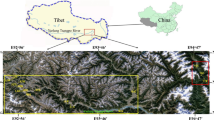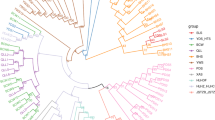Abstract
Cypripedium macranthos var. rebunense is an endangered plant endemic to Rebun Island, Japan. A proper understanding of genetic diversity is needed when conducting conservation programs for rare and endangered species. We therefore examined the genetic diversity of C. macranthos var. rebunense using allozyme markers with a view to future conservation. Our study revealed that C. macranthos var. rebunense has relatively high genetic diversity (P was 0.62, n a and n e were 1.85 and 1.28 respectively, and H o and H e were 0.163 and 0.187, respectively) when compared with other plant taxa. The natural habitats of C. macranthos var. rebunense are geographically separated into northern and the southern populations. Disappearance of alleles and increase in homozygosity expected as a result of the bottleneck effect were observed, particularly in the southern populations composed of a small number of plants. As additional negative effects (inbreeding depression and further genetic drift) due to fragmentation are predicted in these populations, the southern populations may show deterioration of genetic diversity in the near future.



Similar content being viewed by others
References
Aagaard JE, Harrod RJ, Shea KL (1999) Genetic variation among populations of rare clustered lady-slipper orchid (Cypripedium fasciculatum) from Washington State. USA Nat Areas J 19:234–238
Adams JM, Piovesan G, Strauss S, Brown S (2002) The case for genetic engineering of native and landscape trees against introduced pests and diseases. Conserv Biol 16:874–879
Bornbusch AH, Swender LA, Hoogerwerf DL (1994) Genetic variation in Massachusetts populations of Cypripedium arietinum R. Brown in Ait. and C. acaule Ait. (Orchidaceae). Rhodora 96(888):354–369
Brzosko E, Ratkiewicz M, Wroblewska A (2002) Allozyme differentiation and genetic structure of the Lady’s slipper (Cypripedium calceolus) island populations in north–east Poland. Bot J Linn Soc 138:433–440
Cardy BJ, Stuber CW, Goodman MM (1981) Techniques for starch gel electrophoresis of enzyme from maize (Zea mays), revised. Instl. Stat. Mimeogr. Ser. 1317. North Carolina State University
Case MA (1994) Extensive variation in the levels of genetic diversity and degree of relatedness among five species of Cypripedium (Orchidaceae). Am J Bot 81(2):175–184
Case MA, Mlodozeniec HT, Wallace LE, Weldy TW (1998) Conservation genetics and taxonomic status of the rare Kentucky lady’s slipper: Cypripedium kentuckiense (Orchidaceae). Am J Bot 85(12):1779–1786
Cribb P (1997) The genus Cypripedium. Timber Press, Portland
Ehrlén J, Lehtilä K (2002) How perennial are perennial plants? OIKOS 98:308–322
Environmental Agency of Japan (2000) Threatened wildlife of Japan, Red data book 2nd ed., vol 8, Vascular plants. Japan Wildlife Research Center, Tokyo
Forrest AD, Hollingsworth ML, Hollingsworth PM, Cydes C, Bateman RM (2004) Population genetic structure in European populations of Spiranthes romanzoffiana set in the context of other genetic studies on orchids. Heredity 218–227
Frankel OH, Brown AHD, Burdon JJ (1995) The conservation of plant biodiversity. Cambridge University Press, Cambridge
Frankham R, Ballou JD, Briscoe DA (2002) Introduction to conservation genetics. Cambridge University Press, Cambridge
Gottlieb LD (1981) Electrophoretic evidence and plant population. Prog Phytochem 7:1–46
Goudet J (1995) FSTAT (Version 1.2): a computer program to calculate F-statistics. J Hered 86(6):485–486
Hamrick JL, Godt MJ (1989) Allozyme diversity in plant species. In: Brown AHD, Kehler AI, Weir BS (eds) Plant population genetics, breeding and genetic resources. Sinauer Associates, Sunderland, MA, pp 43–63
Hamrick JL, Godt MJ (1996) Conservation genetics of endemic plant species. In: Avise JC, Hamrick JL (eds) Conservation Genetics. Kluwer Academic Publishers, The Netherlands
Hamrick JL, Linhart YB, Mitton JB (1979) Relationships between life history characteristics and electrophoretically detectable genetic variation in plants. Annu Rev Ecol Syst 10:173–200
Hufford KM, Mazer SJ (2003) Plant ecotypes: genetic differentiation in the age of ecological restoration. Trends Ecol Evolt 18:147–155
Jo S, Ochiai M, Furuta K, Yagi K (2005) Genetic analyses of genus Cypripedium found in northern Japan Island and related species endemic to northeast China. J Japan Soc Hort Sci 74(3):234–241
Karron JD (1987) A comparison of levels of genetic polymorphism and self-comparatibility in geographically restricted and widespread plant congeners. Evol Ecol 1:47–58
Karron JD (1991) Patterns of genetic variation and breeding systems in rare plant species. In: Falk DA, Holsinger KE (eds) Genetics and conservation of rare plants. Oxford University Press, Oxford, pp 87–98
Kéry M, Mathies D, Spillmann HH (2000) Reduced fecundity and offspring performance in small populations of the declining grassland plants Primula veris and Gentiana lutea. J Ecol 88:17–30
Kimura M, Crow JF (1964) The number of alleles that can be maintained in a finite population. Genetics 49:725–738
Knight ME, Martin AP, Bishop S, Osborne JL, Hale RJ, Sanderson RJ (2005) An interspecific comparison of foraging range and nest density of four bumblebee (Bombus) species. Mol Ecol 14:1811–1820
Lewis PO, Crawford DJ (1995) Pleistocene refugium endemics exhibit greater allozymic diversity than widespread congeners in the genus Polygonella (Polygonaceae). Am J Bot 82(2):141–149
Luijten SH, Dierick A, Gerard J, Oostermeijer B, Raijmann LE, Nijs HCMD (2000) Population size, genetic variation, and reproductive success in a rapidly declining, self-incompatible perennial (Arnica montana) in the Netherlands. Conserv Biol 14:1776–1787
Mcneely JA, Miller KR, Reid WV, Mittermeier RA, Werner TB (1990) Conserving the world’s biological diversity. IUCN Publication Services, Gland
Miller MP (1997) Tools for population genetic analyses (TFPGA) 1.3: a windows program for the analysis of allozyme and molecular population genetic data. Computer software distributed by author
Miyabe K, Kudo Y (1932) Flora of Hokkaido & Sakhalin 3. J Fac Agric Hokkaido Imp Univ 26:279–387
Nei M (1972) Genetic distance between populations. Am Nat 106:283–292
Nei M (1973) Analysis of gene diversity in subdivided populations. Proc Natl Acad Sci USA 70:3321–3323
Nicolé F, Brzosko E, Bottraud IT (2005) Population viability analysis of Cypripedium calceolus in a protected area: longevity, stability, and persistence. J Ecol 93:716–726
Ohwi J (1965) Flora of Japan (in English). Smithsonian Institute, Washington
Pavlik BM (1994) Demographic monitoring and the recovery of endangered plants. In: Bowles ML, Whelan CJ (eds) Restoration of endangered species. Cambridge University Press, Cambridge, pp 322–350
Ramsay MM (1998) Re-establishment of the lady’s slipper orchid (Cypripedium calceolus L.) in Britain. Bot J Linn Soc 126:173–181
Ranker TA (1994) Evolution of high genetic variability in the rare Hawaiian fern Adenophorus periens and implications for conservation management. Biol Conserv 70:19–24
Robichaux RH, Friar EA, Mount DW (1997) Molecular genetic consequences of a population bottleneck associated with reintroduction of the Mauna Kea Silversword (Argyroxiphium sandwicense ssp. sandwicense [Asteraceae]). Conserv Biol 11:1140–1146
Rossum FV, Sousa SCD, Triest L (2004) Genetic consequences of habitat fragmentation in an agricultural landscape on common Primula veris, and comparison with its rare congener, P. vulgaris. Conserv Genet 5:231–245
Sharma IK, Jones DL, French CJ (2003) Unusually high genetic variability revealed through allozymic polymorphism of an endemic and endangered Australian orchid, Perostylis aff. picta (Orchidaceae). Biochem Syst Ecol 31:513–526
Shimura H, Koda Y (2003) Micropropagation of Cypripedium macranthos var. rebunense through protocorm-like bodies derived from mature seeds. Pl Cell Tissue Org Cult 4633:1–4
Shimura H, Koda Y (2005) Enhanced symbiotic seed germination of Cypripedium macranthos var. rebunense following inoculation after cold treatment. Physiol Pl 123:281–287
Soltis DE, Haufler CH, Darrow DC, Gastony GJ (1983) Starch gel electrophoresis of ferns: a complication of grinding buffers, gel and electrode buffers, and staining schedules. Am Fern J 73:9–27
Soltis PS, Soltis DE (1991) Genetic variation in endemic and widespread plant species: examples from Saxi fragaceae and Polystichum (Dyropteridaceae). Aliso 13:131–134
Sugiura N, Fujie T, Inoue K, Kitamura K (2001) Flowering phenology, pollination, and fruit set of Cypripedium macranthos var. rebunense, a threatened Lady’s Slipper (Orobanchaceae). J Plant Res 114:171–178
Sugiura N, Goubara M, Kitamura K, Inoue K (2002) Bumblebee pollination of Cypripedium macranthos var. rebunense (Orchidaceae); a possible case of floral mimicry of Pedicularis schistostegia (Orobanchaceae). Plant Syst Evol 235:189–195
Taniguchi H, Nakamura T, Mizukami H, Kawano S, Sano H, Katsumi M (2001) Identity of Cypripedium calceolus (Orchidaceae) in Rebun Island: comparative DNA analysis of related species. Genes Genet Syst 76:181–188
Tsumura Y, Tomaru N, Toyama Y, Naim M, Oniwa K (1989) Aisozaimu zikken hou. (Experimental technique of isozyme electrophoresis). The Report of Tsukuba University Experiment Forest. 6:63–95. Tsukuba University
U.S. Fish and Wildlife Service (1994) Recovery plan for the Mauna Kea silversword (Argyroxiphium sandwicense ssp. sandwicense). Portland
Weir BS, Cockerham CC (1984) Estimating F-statistics for the analysis of population structure. Evolution 38:1358–1370
Young AG, Brown AHD, Zich FA (1999) Genetic structure of fragmented populations of the endangered daisy Rutidosis leptorrhynchoides. Conserv Biol 13:256–265
Zhang XP, Li XH, Qiu YX (2005) Genetic diversity of the endangered species Kirengeshoma palmata (Saxifragaceae) in China. Biochem Syst Ecol 34(1):38–47
Acknowledgements
We thank M. Somata, S. Miyamoto, Y. Saito and other islanders for their kind help during the fieldwork on Rebun Island. We also thank Soya Forestry Management Office and Rebun Town. The first author thanks Y. Sato, Y. Kato, G. Sarwar and T. Lackner for their help during fieldwork and grammatical revision of the manuscript. This study was supported by the Ministry of Environment of Japan (Kogai-boshi-to shiken kenkyu) and the Ministry of Education, Culture, Sports, Science and Technology of Japan (Grant-in-Aid for Scientific Research, 16310157).
Author information
Authors and Affiliations
Corresponding author
Rights and permissions
About this article
Cite this article
Izawa, T., Kawahara, T. & Takahashi, H. Genetic diversity of an endangered plant, Cypripedium macranthos var. rebunense (Orchidaceae): background genetic research for future conservation. Conserv Genet 8, 1369–1376 (2007). https://doi.org/10.1007/s10592-007-9287-1
Received:
Accepted:
Published:
Issue Date:
DOI: https://doi.org/10.1007/s10592-007-9287-1




